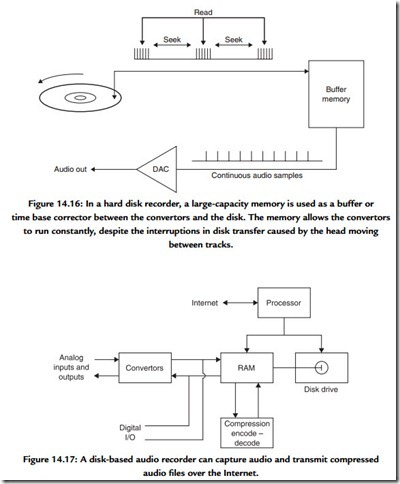Disk-Based Recording
The magnetic disk drive was perfected by the computer industry to allow rapid random access to data, and so it makes an ideal medium for editing. The heads do not touch the disk, but are supported on a thin air film, which gives them a long life but which restricts the recording density. Thus disks cannot compete with tape for archiving, but for work such as compact disc production they have no equal.
The disk drive provides intermittent data transfer owing to the need to reposition the heads. Figure 14.16 shows that disk-based devices rely on a quantity of RAM acting as a buffer between the real-time audio environment and the intermittent data environment.
Figure 14.17 shows the block diagram of an audio recorder based on disks and compression. The recording time and sound quality will not compete with full bandwidth tape-based devices, but following acquisition the disks can be used directly in an edit system, allowing a useful time saving in electronic news-gathering applications.
Development of the optical disk was stimulated by the availability of low-cost lasers. Optical disks are available in many different types, some which can only be recorded once, whereas others are erasable. Optical disks have in common the fact that access is generally slower than with magnetic drives and that it is difficult to obtain high data rates, but most of them are removable and can act as interchange media.
Rotary Head Digital Recorders
The rotary head recorder has the advantage that the spinning heads create a high head-to-tape speed, offering a high bit rate recording without high linear tape speed.
While mechanically complex, rotary head transport has been raised to a high degree of refinement and offers the highest recording density and thus lowest cost per bit of all digital recorders.
Figure 14.18 shows a representative block diagram of a rotary head machine. Following the convertors, a compression process may be found. In an uncompressed recorder, there will be distribution of odd and even samples for concealment purposes. An interleaved product code will be formed prior to the channel coding stage, which produces the recorded waveform. On replay the data separator decodes the channel code and the inner and outer codes perform correction as in Section 14.7. Following this the data channels are recombined and any necessary concealment will take place. Any compression will be decoded prior to the output convertors.
